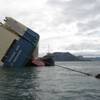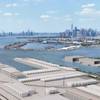In an exclusive interview with “Akti Miaouli” newspaper, BIMCO Chief Shipping Analyst, Peter Sand, provides insight into the markets for dry bulkers, tankers and containerships in 2016 and what to expect going forward.
The BDI reached the all-time-low level in February. It has since started to rebound. Can this recovery be sustained? What are the prospects of the dry bulk market?
Fortunately the BDI has recovered somewhat from the horrific level of 290 on 10 February 2016. Firstly freight rates went higher for the three smaller segments (ex-capesize) on the back of the start of the strong south American grains season. Then a bit later capesizes have followed suit on the back of China lifting its iron ore and coal demand after a sluggish start of the year.
How to sustain the recovery: keep scrapping volumes up, also when freight rates start to pick up and hit USD 10,000 per day. Because the fundamental market balance is still very much off. Overcapacity is serious. The current lift in freight rates is not a result of evaporated overcapacity. The prospects for the dry bulk market is one that spells out a multi-year recovery. If we can keep demolition levels high (around 40m Dwt per annum) for the coming three years while not placing any more new orders. We will bring back a sustainable market, even at low demand growth. We all know what needs to be done, but doing it is still a bit difficult.
What is your view on the sustainability of freight rates in 2016? What trades are under the most pressure at the moment in terms of freight rate levels?
BIMCO remains worried about the sustainability of freight rates in 2016. The demand side seems unable to buoy profits as both Chinese and Indian growth cools off and the rest of the world is still importing smaller volumes than before the financial crisis of 2008. However, we have been positively surprised by the way the market has developed during March going into April. Even coal imports into China was strong in March, bringing Q1 imports almost back on par with the Q1-2015 level. We have also seen Chinese steel export remain high, in spite of the political headwind in some steel producing nations. Before we get carried away, we also have to admit that this fairly positive trade volumes have failed to bring decisive support to the freight rates.
Considering the surplus capacity and current rates, what are the prospects of the container shipping market?
2016 can prove to become quite challenging for the entire industry. The start have already been terrible. All-time-low rates on most of the trades. Last year operator benefitted from the falling oil prices, this year, the same positive effect will not be enjoyed. In order to stay profitable, even by a small margin, costs need to be cut yet again. We have seen longer sailing distance being introduced on the backhauls from US and Europe round the Good Hope. More of this can be expected, regardless of the unprecedented discount put in place by the Suez canal recently. Many years of cascading larger and larger ships to secondary trades have made overcapacity not just a problem on the Far East to Europe trade but a global issue. One that will take many years to unwind. In order to turn it around, the individual carriers must manage their capacity to match demand. Fighting price wars and introducing even bigger ships on any trade is not going to bring profits back in itself.
How do you expect Iran’s return to global trade to impact on the tanker market and what should we expect in this segment in 2016?
BIMCO expect Iran’s return to the oil export market to fairly balanced in the sense that trade lanes may change, but the overall demand situation for tankers is expected not to change. As Iran takes market charge from neighbouring countries doesn’t matter that much. But to the extent that Iran replace West African exports into Asia, the contribution will be negative. So for the development has been more or less along the lines, expected by BIMCO – a slow record, one slower than many was hoping for. But what has surprised us a bit is the hesitant approach to undercut prices to gain market shares. In short, Iran may take many headlines – well deserved, but it remains the inflow of crude oil tankers which will put the freight rates under downward pressure as the year passes.
Are current demolition levels sufficient to bring about market balance in the remainder of the year?
It’s net fleet growth that matters, not just demolition. For dry bulk, the market may actually be in balance this year. But a balanced year, merely means the conditions of 2015 will stick around. That’s not nice to have another year like 2015. What the dry bulk industry needs is multiple years where demand outstrips supply. Only by doing that higher utilisation may be achieved and then better freight rates will also follow. For the container industry, BIMCO expect that the demand side will not keep up with supply growth. Even though the containership fleet has never grown so slowly before. As the GDP-to-trade multiplier for container shipping is 1 at the moment and global GDP, according to IMFs recent downward revision will only grow by 3.2% this year – a supply growth at 3.4% for the containership fleet will bring more misery to the market. Time charter rates and their duration tells the same story.
In terms of the global economy, what do key economic parameters show? Is shipping in for a tough year?
Yes, shipping is in for a tough year. We are candid about that. And we have to be, because it seems as if shortage of insight into the fundamental facts of the supply and demand balance in the past, has prompted owner and investor to become optimistic too early. Placing a lot of orders, which has now extended the eventual recovery once more. The global economy is not providing such a strong support the industry players which prove extremely price competitive seaborne transportation which should facilitate trade. The world has simply changed in many ways in the years that have followed in the wake of the big crisis in 2008. The industry needs to reset its cost level and focus fully on adapting to this new normal to stay a part of the future business.






